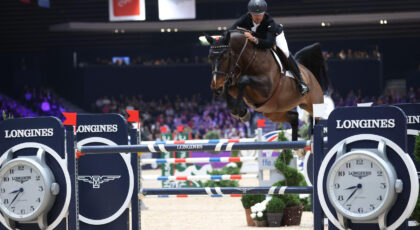Yes, I’m one of those barefoot people.
And no, I do not consider myself a fanatic. If you want to put shoes on your horse that’s your prerogative. That being said, there are many benefits to barefoot and I’m always happy to inform people about them. As much as I hate to say it barefoot isn’t always the easy route, because it’s not just about pulling the shoes—it’s about providing the necessary framework for your horse to thrive without metal on his feet. If we don’t provide this framework then the odds of barefoot success are about as good as a team roper winning a blue ribbon in a hunter jumper class.
When transitioning a horse from shoe to shoeless we need to be realistic in our expectations. A horse that has been shod for ten years isn’t likely to be immediately comfortable walking barefoot on gravel (although I have heard of this happening). If your horse is like most, they’ll need at least six months to fully adjust.
So if you’re interested in making the switch, here are a few tips to help you and your horse survive this transition time and hopefully gallop into a wonderful, barefoot world.
1. The Right Trim: First off, there is a difference between just trimming a hoof and doing a barefoot trim. Make sure you hire an experienced barefoot trimmer, preferably someone who doesn’t shoe. My husband was a farrier at one time, and the way he trims versus the way I’ve learned to trim (per Pete Ramey) are quite different.
2. Trim Frequency: Finding the best trim frequency is important because if you allow for too much overgrowth, then the hoof really isn’t going to function as it should (with the wall, sole, bars, and frog all sharing the weight-bearing). The trim frequency your horse needs will depend on several factors, most importantly, his environment. Horses who move over varied terrain on a regular basis are going to self-trim some, whereas horses who don’t move a lot, or those who live in soft or soggy pastures will usually need more frequent trimming. This could range from every two to three weeks to as much as every few months (for horses in very arid, rocky environments).
3.) Diet is Crucial: The state of the hooves will often reflect the horse’s overall health, and horses lacking specific vitamins and minerals, omega 3’s or even protein will often have poorer feet. A good vitamin/ mineral supplement is often necessary, especially for horses who don’t have 24/7 access to good quality pasture. Adding some legume hay (such as alfalfa) in with your grass hay is a great way to supplement protein. Also, don’t forget about trace minerals. Though they’re needed in very small amounts, zinc, copper, and selenium are of great importance for hoof health.
4.) Cut the Sugar! This goes along with diet, but too much sugar is bad for hooves as well as overall health. Green grass is often already high in sugars, but add to that many of the commercial feedstuffs horses are fed, and this can really thwart barefoot progress. Sugars should eliminated as much as possible. This means no sweet feed, and we should also look at the NSC (non-structural carbohydrate) value of feedstuffs. For example, 12% NSC is far better than 38%.
Green grass can be a double-edged sword—though it contains many vitamins and is high in omega 3’s, the sugars in it may be too much for some horses. Limiting grass intake can often make a big difference. (This isn’t to say you should starve them—most grass hays are much lower in NSC’s than fresh grass and should always be made available to horses not on pasture.)
5.) Treat thrush: Thrush is another big issue I’ve seen in both shod and barefoot horses. You may think of thrush as being foul-smelling and easy to identify, but that’s not always the case. In fact, many horses with a deep split in their central sulcus (center of frog) are suffering from thrush. There are multiple ways to combat this and I suggest aggressive treatment for the best results.
6.) Movement: Horses who move are going to have better feet than those who don’t. Not only does movement increase circulation in the feet, it also toughens the sole and provides for natural wear of the hoof. So if your horse can’t be in a pasture, moving around with other horses, I suggest exercising him daily for at least an hour. Otherwise, you may never get the barefoot results you want.
7.) Varied Terrain: Better than just plain movement, is movement over varied terrain. Rougher surfaces will naturally toughen and abrade the hooves. Adding pea gravel to stalls or another area your horses frequent (such as around the water trough) is often an excellent idea. But so is gradually increasing your riding time over rougher terrain. The bottom line is this: you can’t expect a horse who lives on soft pasture to suddenly have tough feet on rocky trails. But also keep in mind that you should never force a horse over rocky terrain when it causes obvious discomfort.
8.) Use Hoof Boots when needed: I’m going to let you in on a little secret: barefoot horses don’t have to be barefoot 100% of the time, especially when you’re transitioning from shoes to barefoot. Hoof boots can be great for trails or riding on rougher terrain. You can usually find a good pair for less than $200, which after multiple uses, is much cheaper than shoeing. Another great thing about hoof boots is that they still allow for the natural expansion and contraction of the hoof (unlike metal shoes).
9.) Be Patient: Transitioning to barefoot is a process and, as I stated earlier, it may take six months or more for your horse to become completely comfortable. But give it time—the benefits of barefoot are worth it!
10.) Modify Trim if Needed: Something else to keep in mind is that if you’re not happy with how your horse is doing barefoot, you may need to talk with your trimmer about changing the trim (or find a new trimmer). Not all barefoot trimmers trim exactly alike. Likewise, a trim that works for one horse, may not work for another. Personally, I use the less is more philosophy while trimming, especially on horses just converting to barefoot. If your trimmer is trimming too much at once, there’s a chance your horse could continue to be footsore.



 March 3, 2017
March 3, 2017 




























